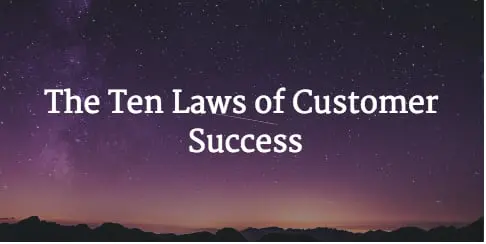Bessemer’s original ten laws were “The Ten Laws of Cloud Computing” in 2010. Based on the success of that publication, they commissioned “The Ten Laws of Customer Success” in 2015 to address the burgeoning popularity (and necessity) of Customer Success. Over the next few weeks, we’ll explore the new ten laws in some depth.
The audience for “The Ten Laws of Customer Success” is CEOs and other executives at recurring revenue companies because the philosophy of Customer Success, as opposed to the discipline of Customer Success, needs to be a top-level commitment at any company that is serious about retention and about maximizing the value of their installed base.
So “The Ten Laws of Customer Success” is not a tactical guide to the daily life of a Customer Success Manager. It won’t help you determine your customer segmentation and touch models. And it won’t help you figure out where to put Customer Success organizationally. What it will do is provide guidance with regard to what the entire company needs to do well in order to be a great recurring revenue business. Not coincidentally, the first law is “It’s a Top-Down Companywide Commitment”. Perhaps more than any other organization, Customer Success cannot be an island. It is not the group of people who catch everything that rolls to the bottom of the hill from customers. It’s not the group of people who make up for every other organization’s mistakes. In fact and very importantly, the primary responsibility of Customer Success leadership (including the CEO) is to force every other organization to think about retention and the long-term success of their customers. This responsibility requires your CEO and your board to be 100% committed to the cause. And this can’t be a lip-service commitment – it takes real investment and very difficult decisions in order to make it work. At some point in the life of a recurring revenue company someone will have to make a very tough call on whether retention is more important than your quarterly sales number. Is someone willing to say “no” to a prospect because your ability to make them successful is sufficiently low? That’s a very tough call and ultimately will likely have to be made by your CEO.
It follows logically that virtually all of these ten laws have cross-functional applicability. Law #2 is a perfect example, which we just touched on – “Sell to the Right Customer”. Retention success will not come to those who violate this law. This responsibility can’t rest only on the shoulders of the VP of Customer Success. Your VP of Sales has to be bought in, too. Similarly with Law #4 – “Obsessively Improve Time-to-Value”. That’s not just the job of your onboarding team or your Customer Success team. It’s the combination of those two along with Sales setting the proper expectations. All parts of the company must participate equally with an eye on lifetime value, not short-term sales numbers.
This market turn towards the subscription economy creates organizational pressure in a lot of new ways. For years, the focus on customers was lukewarm at best. How much did enterprise software companies really care about shelfware if their $3M was already in the bank? But today, the spotlight on customers burns very hot and, not coincidentally, all of the power has shifted to the customer. No more selling and forgetting. Every part of your company has to be focused on the long-term view of customer value and truly delivering a great experience and business value. This requires not only a new organization called Customer Success, but also a new customer success-centric philosophy across the company and these ten laws can help form the basis for that new philosophy.
There’s certainly no magic in the number “10”. There are many related initiatives that will fall under the Customer Success umbrella. But these ten have been vetted by many of the leaders in the SaaS and Customer Success market, and written by ten different individuals from nine different companies. The result is a broad perspective on Customer Success and how to empower the right focus across all organizations in different types of companies.
They are also not yet etched on stone tablets so they may change over time. Customer Success is still so new that the odds of anything specific staying as it is today are relatively small. However, the odds of the foundational elements of a customer success-centric philosophy remaining constant are much higher and that’s the approach we took with these laws. At the same time, they are practical and can be adopted and ingrained as part of your company’s focus pretty quickly.
Over the next few weeks, in blogs and webinars, we’ll dig into the details on several of the ten laws and share best practices and experiences in making them work. We hope you’ll join us in this journey and look forward to hearing your questions and your experiences, too.

